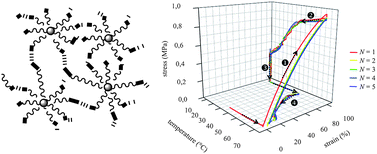Star-shaped POSS-polycaprolactone polyurethanes and their shape memory performance†
Abstract
Star-shaped

* Corresponding authors
a
Institute of Materials Research and Engineering, (A*STAR) Agency for Science, Technology and Research, 3 Research Link, Singapore, Singapore
E-mail:
ky-mya@imre.a-star.edu.sg
Fax: +65 68727744
Tel: +65 68748422
b
BAM Federal Institute for Materials Research and Testing, Division VI.3, Durability of Polymers, Unter den Eichen 87, Berlin, Germany
E-mail:
Thorsten.Pretsch@bam.de
Fax: +49 030 8104 1617
Tel: +49 030 8104 3804
c
Department of Material Science and Engineering, National University of Singapore, Engineering Drive 4, Singapore, Singapore
E-mail:
cb-he@imre.a-star.edu.sg
Star-shaped

 Please wait while we load your content...
Something went wrong. Try again?
Please wait while we load your content...
Something went wrong. Try again?
K. Y. Mya, H. B. Gose, T. Pretsch, M. Bothe and C. He, J. Mater. Chem., 2011, 21, 4827 DOI: 10.1039/C0JM04459H
To request permission to reproduce material from this article, please go to the Copyright Clearance Center request page.
If you are an author contributing to an RSC publication, you do not need to request permission provided correct acknowledgement is given.
If you are the author of this article, you do not need to request permission to reproduce figures and diagrams provided correct acknowledgement is given. If you want to reproduce the whole article in a third-party publication (excluding your thesis/dissertation for which permission is not required) please go to the Copyright Clearance Center request page.
Read more about how to correctly acknowledge RSC content.
 Fetching data from CrossRef.
Fetching data from CrossRef.
This may take some time to load.
Loading related content
